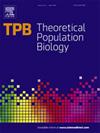Exact calculation of the expected SFS in structured populations
IF 1.3
4区 生物学
Q4 ECOLOGY
引用次数: 0
Abstract
The Site Frequency Spectrum (SFS), summary statistic of the distribution of derived allele frequencies in a sample of DNA sequences, provides information about genetic variation and can be used to make population inferences. The exact calculation of the expected SFS in a panmictic population under the infinite-site model of mutation has been known in the Markovian coalescent theory for decades, but its generalization to the structured coalescent is hampered by the almost exponential growth of the states space. We show here how to obtain this expected SFS as the solution of a linear system. More precisely, we propose a complete algorithmic procedure, from how to build a suitable state space and sort it, to how to take advantage of the sparsity of the rate matrix and to solve numerically the linear system using an iterative method. We then build a specialization for the simplest case of the symmetrical -island model to arrive at a ready-to-use software called SISiFS from which a demographic parameters inference framework could easily be developed.
结构种群中预期SFS的精确计算。
位点频率谱(Site Frequency Spectrum, SFS)是对DNA序列样本中衍生等位基因频率分布的汇总统计,它提供了遗传变异的信息,可用于群体推断。在马尔可夫聚结理论中,对于无限位点突变模型下的泛生种群期望SFS的精确计算已经有几十年的历史了,但由于状态空间几乎呈指数增长,阻碍了它向结构聚结的推广。我们在这里展示如何获得这个期望的SFS作为线性系统的解。更准确地说,我们提出了一个完整的算法过程,从如何建立一个合适的状态空间并对其进行排序,到如何利用率矩阵的稀疏性,并使用迭代方法对线性系统进行数值求解。然后,我们为对称n岛模型的最简单情况建立专业化,以获得一个称为SISiFS的即用型软件,从中可以轻松开发人口统计参数推断框架。
本文章由计算机程序翻译,如有差异,请以英文原文为准。
求助全文
约1分钟内获得全文
求助全文
来源期刊

Theoretical Population Biology
生物-进化生物学
CiteScore
2.50
自引率
14.30%
发文量
43
审稿时长
6-12 weeks
期刊介绍:
An interdisciplinary journal, Theoretical Population Biology presents articles on theoretical aspects of the biology of populations, particularly in the areas of demography, ecology, epidemiology, evolution, and genetics. Emphasis is on the development of mathematical theory and models that enhance the understanding of biological phenomena.
Articles highlight the motivation and significance of the work for advancing progress in biology, relying on a substantial mathematical effort to obtain biological insight. The journal also presents empirical results and computational and statistical methods directly impinging on theoretical problems in population biology.
 求助内容:
求助内容: 应助结果提醒方式:
应助结果提醒方式:


